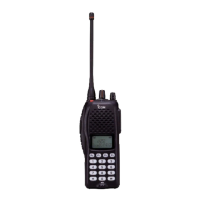
Do you have a question about the Icom IC-F31GT and is the answer not in the manual?
| Brand | Icom |
|---|---|
| Model | IC-F31GT |
| Category | Transceiver |
| Language | English |
Emphasizes the importance of reading all instructions before operating the transceiver.
Highlights that the manual contains essential operating instructions for the transceiver.
Guidance on microphone and antenna positioning for optimal transmission.
Advice on maintaining antenna separation from the body when wearing the radio.
Warnings regarding transceiver proximity to the body during transmission.
Guidance on operating temperature ranges and avoiding direct sunlight.
Cautions on battery shorting, modification, and use of non-Icom accessories.
Lists the accessories supplied with the transceiver.
Instructions for screwing the antenna onto the transceiver.
Instructions on how to attach and release the belt clip.
Identification of the transceiver's physical switches, controls, keys, and connectors.
Reference table for programmable keys and their potential functions.
Details on the antenna connector, PTT switch, keypad, and multi-connector.
Explanation of the function of dealer-programmable keys F0-F3 and P0-P3.
Information on the transceiver's display screen and its basic purpose.
Explanation of icons and indicators shown on the function display.
Step-by-step guide for safely replacing the battery pack.
Details on different battery packs and their respective charging periods.
Important warnings regarding battery shorting, incineration, water, and cleaning.
Instructions for rapid charging using the BC-144 charger.
Information on using the AD-99 spacer with specific charging setups.
Details on rapid charging multiple battery packs simultaneously with the BC-121.
Instructions for regular charging of battery packs using BC-137 or BC-146.
Guidance on first-time charging, temperature, and usage recommendations.
Information on extending battery pack life and when replacement is needed.
How to install alkaline batteries into the optional BP-208 battery case.
Important safety precautions when using the optional battery case.
Introduction to programmable function names and switch activation.
Instructions for locking and unlocking the transceiver's keypad.
How to select a pre-programmed priority channel using a switch.
Details on starting, stopping, and managing channel scanning.
How to switch between high, low1, and low2 transmit power output.
Information on the optional scrambler unit and its operation.
How to manually open the squelch to check channel activity.
How to switch between duplex and simplex communication channels.
Methods for sending DTMF codes manually or automatically.
How to quickly re-transmit the last used DTMF code.
Procedure for sending an emergency signal to the base station.
Options for setting the display backlight to ON, OFF, or AUTO.
Overview of SmarTrunk II™ capabilities and channel bank selection.
Fundamental steps for receiving signals and transmitting voice.
Steps for initiating calls using selective or non-selective tone signalling.
How to select a Tx code channel for use with call functions.
Instructions for manually sending 5-tone codes via the keypad.
Explanation of the Time-Out Timer and Penalty Timer functions.
How to initiate and receive dispatch calls using the PTT button.
How the transceiver indicates if all channels are busy.
Instructions for answering subscriber-to-subscriber and landline calls.
How to terminate a call using the disconnect function.
Features for redialing the last number and using speed dial keys.
Steps to program telephone or subscriber numbers into memory.
Notification when an open channel becomes available for use.
Procedure for initiating an emergency call.
Instructions for making calls to external phone numbers.
How to call other subscribers within the SmarTrunk II™ system.
Explanation of DTMF paging for notifications and code squelch for filtering audio.
Step-by-step instructions for installing optional units into the transceiver.
Overview of transferring programmed contents using cloning software.
Details on available optional battery packs like BP-208, BP-209, and BP-210.
Information on various optional chargers for battery packs.
Details on optional voice scrambler and trunking board units.
Lists other accessories such as earphone adapters, antennas, and headsets.